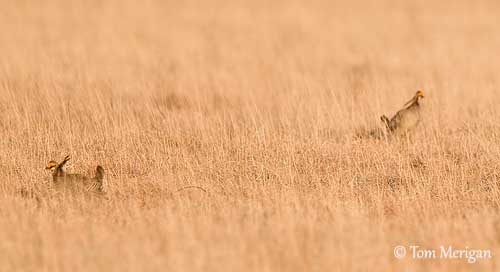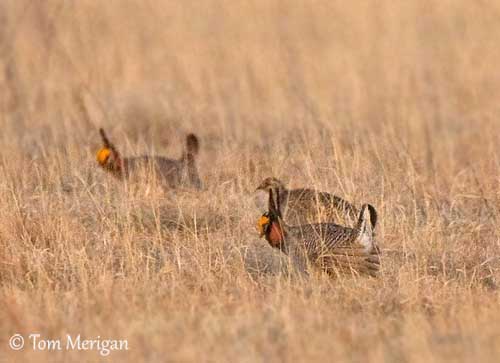
Fr: Tétras pâle
All : Kleines Präriehuhn
Esp : Gallo de las Praderas Chico
Ital : Tetraone minore delle praterie
Nd : Klein Prairiehoen
Sd : Mindre präriehöna
Photographer :
Tom Merigan
Tom Merigan’s Photo Galleries
Text by Nicole Bouglouan
Sources :
HANDBOOK OF THE BIRDS OF THE WORLD Vol 2 by Josep del Hoyo-Andrew Elliot-Jordi Sargatal - Lynx Edicions - ISBN: 8487334156
FIELD GUIDE TO THE BIRDS OF NORTH AMERICA - National Geographic Society - ISBN: 0792274512
BirdLife International (BirdLife International)
All About Birds (Cornell Lab of Ornithology)
Lesser Prairie-chicken
Tympanuchus pallidicinctus
Galliforme Order – Tetraonidae Family
BIOMETRICS:
Length: 38-41 cm
Weight: M: 790 g – F: 700 g
Note from the photographer Tom Merigan:
These shots were taken in dim dawn light and were photographed at a great distance between the lek and the blind. But it does capture their jumps in the displays.
DESCRIPTION:
The Lesser Prairie-chicken is a smaller version of the Greater Prairie-chicken. It is paler overall and less heavily barred below.
Outside the breeding season, both sexes are almost similar with mostly brown plumage barred blackish, providing an excellent camouflage to this terrestrial species.
The male has short, rounded black tail, whereas the female has barred tail similar to upperparts. In male, undertail feathers are white with small black spots, exposed during the displays when the tail is cocked.
The underparts are paler, sandy to greyish-brown, barred dark brown. Chin, throat and upper foreneck are creamy-white.
The male shows long black, white and buff feathers called “pinnae” on the neck sides. These elongated feathers erect during the displays and form “horns” or “erect-tufts” on each side of the head. It has yellow comb above the eye, becoming larger and brighter when displaying.
In the same way, the orange-red air-sacs situated on neck sides and inconspicuous at rest, are inflated and become bright red-orange when displaying.
The female has similar appearance but slightly duller. She has shorter feathers on neck sides. The yellow combs are duller and narrower and she lacks the air-sacs or they are inconspicuous. Her tail is barred above and undertail-coverts are white.
Both sexes have horn-coloured bill. The eyes are chestnut-brown. The feathered legs and the bare feet are pale buff.
The juvenile shows shaft streaks on scapulars.

VOICE: SOUNDS BY XENO-CANTO
The Lesser Prairie-chicken male produces booming calls during the courtship displays. The air-sacs are inflated in order to make bubbly boom sounds.
It also utters cackling and clucking notes, and series of raucous or nasal calls while strutting.
HABITAT:
The Lesser Prairie-chicken is largely sedentary in sandy dry grasslands, sagebrush (Artemisia filifolia) and short-grass prairie areas with shinnery oaks for acorns (Quercus havardii).
During winter, they live in grass cover areas but they roost mainly in shrubs. They feed close to oaks where they find acorns.
Displays take place in short-grass prairie country with ridges or other elevated places.
They nest in low shrubs or among clumps of grass. Later, the brood moves to thicker cover.
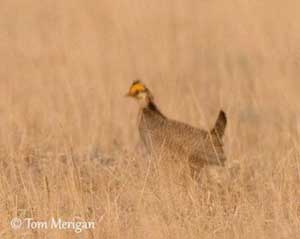
RANGE:
The Lesser Prairie-chicken is found in SE Colorado, SW Kansas, Oklahoma, E New Mexico and NW Texas.
BEHAVIOUR:
The Lesser Prairie-chicken feeds on plant matter such as seeds, berries, leaves, buds, acorns and waste grain. It also takes insects in higher percentage than the Greater Prairie-chicken. Insects are their main food during summer.
During winter, they feed on cultivated plant species, sunflower and sorghum, especially during the snowy periods.
During the very harsh winters, the Lesser Prairie-chicken burrows into the snow to shelter and provide warmth when the temperatures descend between -40°C and -50°C. But this species also needs areas of thick, shaded bush cover to maintain a constant internal temperature during warmer seasons.
During fall and winter, they may form flocks of about 70-80 birds.
At the beginning of the breeding season in spring, males use a “lekking” system for competition between them and to attract females.
They gather at a lek or display ground, situated in short-grass prairie area where elaborated courtship displays are performed. Females visit the lek and look at males in order to select a mate.
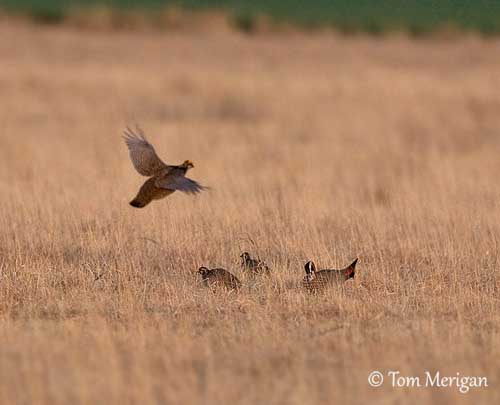
When displaying, the male has very conspicuous yellow eye-combs. The long feathers of the neck sides are erect, similar to “horns” on each side of the head. The red-orange air-sacs are inflated while the bird raises the neck. The tail feathers are fanned and raised too, producing “tail-clicking”. The wings are dropped and touch the ground, but “wing-shaking” occurs too. The male beats the ground rapidly with its feet and runs alongside other males.
During these displays, we can hear sometimes far-carrying, low-pitched booming sounds. If females are approaching, the males bow and then, jump into the air while fluttering strongly and calling. Displays take place at dawn and dusk.
However, aggressive encounters between males may occur, sometimes so violent that they can end up causing serious injuries.
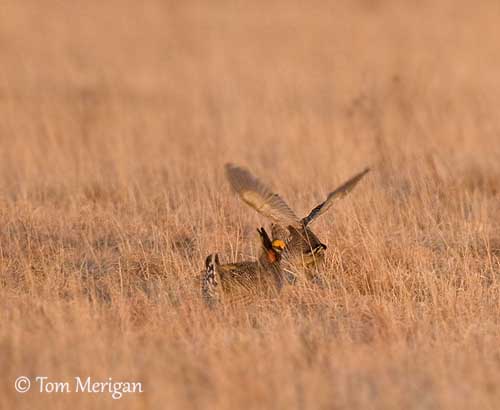
The female selects a male basing her on visual factors such as beauty of plumage, displays and fights, but also sounds. After mating, the female does not receive any help from the male in nesting duties.
The Lesser Prairie-chicken is largely sedentary in its range, but females and juveniles may move farther.
FLIGHT:
Like other Tetraonidae species, the Lesser Prairie-chicken is able to fly very well once a good speed is got, but it is often reluctant to take flight.
REPRODUCTION:
The laying occurs usually in April-May.
The Lesser Prairie-chicken female selects a nest-site where she prepares the nest, a depression scratched into the ground and lined with grasses and feathers, well hidden amongst the long-grass cover. Her cryptic plumage provides her a good camouflage in such environment.
She lays 11-14 greyish-olive eggs and incubates alone during 24-25 days. The downy chicks have black spots on top of head and one on forehead. They also have small black markings on the upperparts.
She will lead her brood away from the nest a few hours after the last chick has hatched. She moves with the chicks into areas with high density of insects in open spaces with bare ground.
They remain together during 8-10 weeks before to disperse. The young birds are sexually mature at one year old.
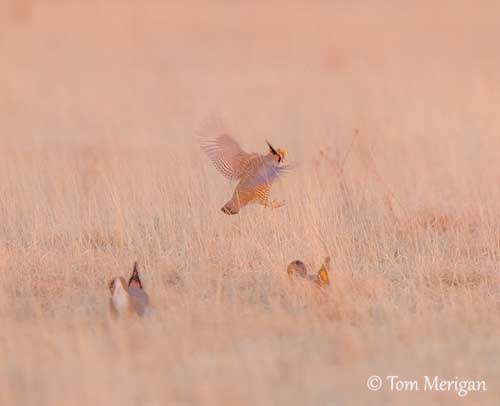
DIET:
The Lesser Prairie-chicken feeds on corn, oat, wheat, rye, grain, sorghum and various small grain crops left after harvest.
During the autumn, it takes seeds and other plant matter and insects too. During winter, it feeds on oak acorns, sage leaves, seeds from wild plants, fruits and flowers.
It feeds by walking and pecking at ground.
PROTECTION / THREATS / STATUS:
The Lesser Prairie-chicken’s populations have declined, and although stabilization and even some increase since 1995, they remain threatened by effects of drought and habitat loss.
This species is currently retained as Vulnerable by BirdLife International.
